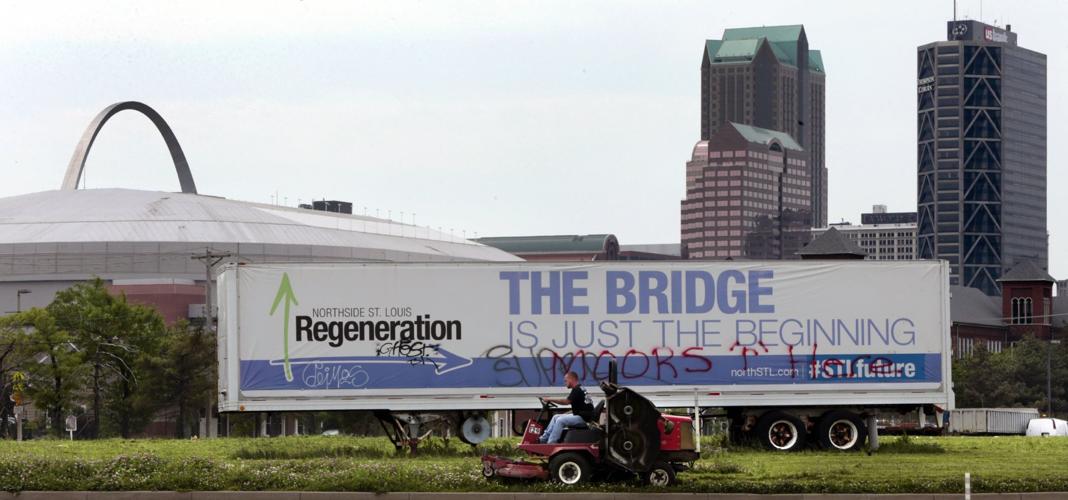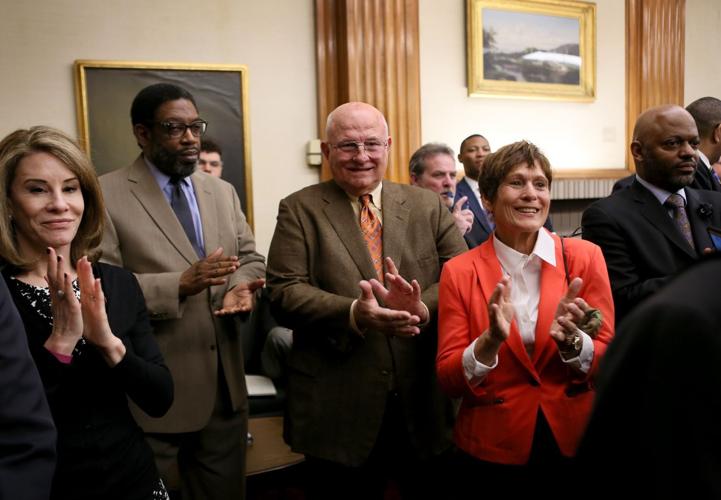An attorney for the city of 51║┌┴¤ on Thursday called a transaction between developer Paul McKee and the former owner of the Buster Brown shoe factory a ÔÇ£shamÔÇØ where no money exchanged hands except Missouri tax credits that the two sides split.
The allegation, and email evidence to support, were revealed in the second day of a that has since been razed to make way for the National Geospatial-Intelligence AgencyÔÇÖs western headquarters.
Former Buster Brown owner Jim Osher in 2011 agreed to seller-finance the building at 1516 North Jefferson Avenue to McKee and continue leasing it ÔÇö with lease payments equaling the interest payments McKee then sent him, city lawyers say. Those interest payments triggered the issuance of Missouri tax credits under a former state program that McKee was able to tap for over $40 million over the last 10 years while assembling land in north 51║┌┴¤.
People are also reading…
Those interest credits were on top of the tax credits issued based on 50 percent of the sale price ÔÇô an amount city lawyers alleged Wednesday was inflated to maximize the amount of tax credits issued by the state. Attorneys for McKee say it was a ÔÇ£key cornerÔÇØ and that they didnÔÇÖt overpay.
The only principal payment to Osher was $591,000, paid to Osher after McKeeÔÇÖs NorthSide Regeneration obtained and sold Distressed Area Land Assemblage tax credits from the deal in 2012. McKee was to keep the remaining tax credits or used them to pay professional fees for the transaction.
But once the state Department of Economic Development, in early 2013, flagged the transaction and refused to issue credits for the interest payments, Osher stopped paying rent and McKee stopped paying interest. The Department of Economic Development eventually recouped the credits for the sale by reducing the amount of credits McKee would have received on other transactions.
Yet for two years, despite no rent or principal payments, neither side moved to trigger default. McKeeÔÇÖs NorthSide Regeneration continued as the owner, and Osher continued leasing.
It was only in 2015, when the National Geospatial-Intelligence Agency was looking to move to a new campus and the city needed to acquire the building as part of assembling a site for the federal agency, that the deal was ÔÇ£unwound,ÔÇØ attorney Jerry Carmody said, and the property deeded back to Osher.
Since then, Osher has battled the city in court over the value of the building, which the city used eminent domain to acquire. His litigation challenging the cityÔÇÖs value, paid via eminent domain, for his Buster Brown building has shed new light on how a state program many saw as written for one man ÔÇö McKee ÔÇö may have been abused.
The trial is really over the value of the Buster Brown building ÔÇö which the city took in July 2016 and ultimately paid a little over $800,000 for. Osher argues its value is closer to $5.5 million and has taken the action all the way to a jury trial.
Still, details of OsherÔÇÖs transactions with McKee have been a key part of evidence and witness testimony. Emails, contracts and other documents obtained via discovery from McKee affiliates and attorneys and those held by Osher shed light on not just the Buster Brown transaction, but other interactions between Osher and McKee.
With days left before the city said it wouldn't offer more tax credits, McKee finalizes $10 million private loan. 
In late 2011, Osher had a letter of intent to sell three buildings to McKeeÔÇÖs company ÔÇö Buster Brown, another on Magazine Street and another nearby building for about $6.4 million. Two of the buildings Osher had recently bought for $65,000. Osher bought Buster Brown in the 1990s for $200,000.
But then, two of the properties were left off of the transaction and only Buster Brown was included. While the original letter of intent Osher signed agreed to sell the Buster Brown building for $3.16 million, the sale price increased to $3.75 million after the two other buildings were left off the final sale.
Were the other two buildings left off the final sale, Carmody asked Osher on the stand, because ÔÇ£the numbers you were talking about would draw scrutiny from the Department of Economic Development?ÔÇØ
Osher said he couldnÔÇÖt recall.
Carmody then pointed to an email from Russell Caplin, a longtime McKee associate who worked in finance for the developerÔÇÖs former McEagle Properties, about the final sale including only Buster Brown.
ÔÇ£Obviously itÔÇÖs not as attractive to either party as the previous discussion, but I think it has a higher likelihood of a good outcome,ÔÇØ Caplin wrote.
That good outcome is Department of Economic Development approval, right? Carmody asked. ÔÇ£I assume so,ÔÇØ Osher said.
McKee lawyer Lynn Carey at Stone Leyton Gershman said in an emailed response to questions that there was nothing ÔÇ£nefariousÔÇØ about the timing of the purchase.
ÔÇ£In light of the difficult and time consuming negotiation with Osher, NorthSide decided to concentrate on the property most significant to its development activities (Buster Brown), rather than trying to focus on negotiating terms for multiple properties at once,ÔÇØ Carey wrote.
An email from an Osher lawyer sent during negotiations asked to include a way to unwind the deal if the state didnÔÇÖt issue tax credits for the deal ÔÇ£since everything is contingent on obtaining tax credits,ÔÇØ she wrote.
McKeeÔÇÖs NorthSide Regeneration project has been controversial since it was discovered the developer was buying up land in beleaguered north 51║┌┴¤ neighborhoods. The Distressed Area Land Assemblage tax credits to offset land purchases ÔÇö created by legislation McKee lawyer Steve Stone helped write ÔÇö helped him amass 1,500 acres north of downtown.
McKee eventually won the blessing of the city, which designated him developer of the area and promised future development subsidies if projects started happening. Yet his relationship has soured with City Hall over the years as complaints mounted about the lack of development and deteriorating buildings he owned. One of his construction projects has recently started along Tucker Boulevard north of downtown.
McKee argues the NGA wouldnÔÇÖt have decided to relocate to north 51║┌┴¤ had he not started assembling land and made the initial pitch to the federal government. But the city was ultimately forced to buy back land it had sold to him within the future footprint of the NGA site.













